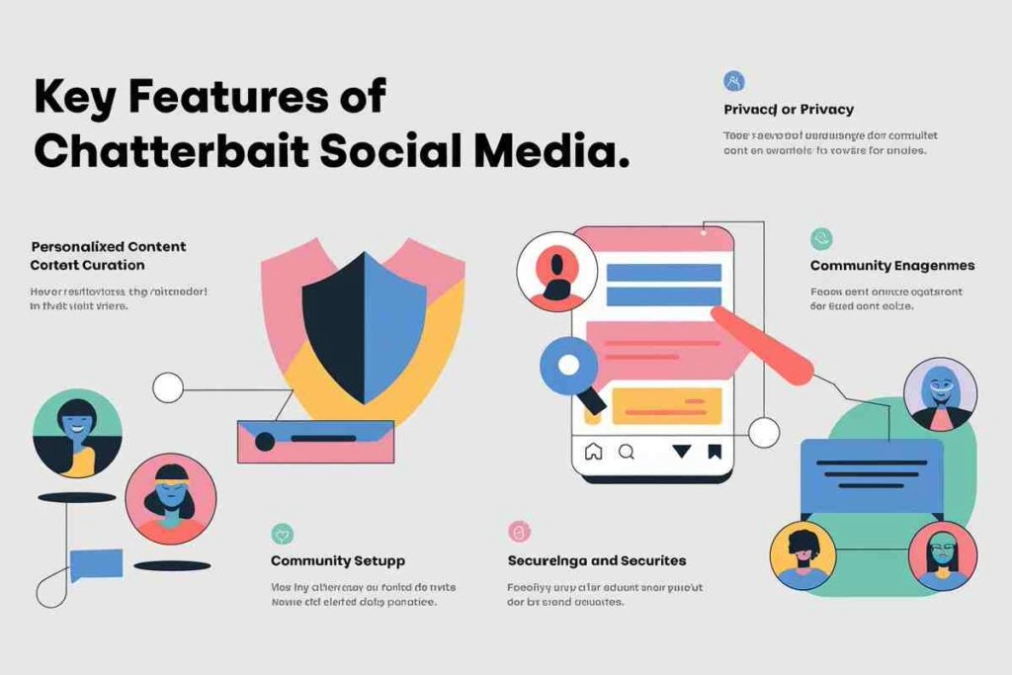Chatterbait Social Media: Navigating Its Unique Content Moderation Landscape

In the ever-evolving ecosystem of social media, a new breed of Chatterbait Social Media platforms is emerging, prioritizing dynamic, conversation-driven engagement over passive scrolling. Chatterbait Social Media stands at the forefront of this shift, built on the core philosophy that authentic, rapid-fire dialogue is the ultimate “bait” for user attention and community building. However, this very strength – its relentless focus on real-time, user-generated conversation – presents unprecedented challenges in the critical arena of content moderation. Navigating Chatterbait’s unique moderation landscape isn’t just advisable; it’s essential for creators, brands, and the platform’s long-term health.
Why Chatterbait’s Moderation Can’t Be an Afterthought

Traditional Chatterbait Social Media platforms often deal with static posts (images, videos, lengthy text) or slower-paced comment threads. Moderation, while complex, can often be applied reactively or algorithmically with some degree of success after the content is live. Chatterbait Social Media: Navigating Its Unique Content Moderation Landscape flips this model:
- Conversation is the Core Product: Unlike platforms where content leads to comments, on Chatterbait Social Media: Navigating Its Unique Content Moderation Landscape, the conversation thread is the primary content. Each “bait” (a provocative question, hot take, or snippet) is designed explicitly to ignite rapid, multi-participant dialogue.
- Velocity and Volume: Discussions explode in real time. A single successful bait can generate hundreds of comments, replies, and tangents within minutes. This sheer speed and volume overwhelm traditional human review processes.
- Context is King (and Complex): Harm often arises not from a single comment, but from the flow of conversation – escalating arguments, dogpiling, subtle harassment woven into seemingly normal replies, or bait-and-switch tactics where a benign start leads to toxic territory. Understanding this context is crucial but incredibly difficult at scale.
- The “Bait” Paradox: The very mechanics that make Chatterbait Social Media engaging – provocative hooks, emotional appeals, debate prompts – are the same tactics often used by bad actors to spread misinformation, incite anger, or lure users into harmful interactions. Distinguishing between good-faith debate and malicious bait is a constant tightrope walk.
Deconstructing Chatterbait’s Moderation Framework (The Knowns and Unknowns)
While specific algorithms are proprietary, Chatterbait’s public statements, observable patterns, and the nature of its platform suggest a multi-layered approach still very much under development:
- Algorithmic First Line of Defense (Pre- & Post-Engagement):
- Keyword & Pattern Flagging: Basic detection of slurs, threats, and known spam/phishing phrases. However, sophisticated trolls constantly evolve language (e.g., misspellings, coded language, memes).
- Engagement Velocity Analysis: Algorithms likely monitor how quickly a thread generates replies and the sentiment trajectory. An unusually rapid spike in negative or hostile replies might trigger review throttling or temporary shadowing.
- User Reputation Scoring: Users are likely assigned trust/safety scores based on history (reports against them, previous violations, positive contributions reported by others). High-risk users might have their comments pre-moderated or deprioritized.
- Network Analysis: Identifying clusters of accounts engaging in coordinated harassment or spam campaigns.
- Proactive Measures (Attempting to Shape the Conversation):
- “Conversation Starters” Guidelines: Chatterbait Social Media likely provides creators with best practices for framing bait to encourage constructive dialogue and discourage flame wars (e.g., emphasizing “why” questions, and inviting diverse perspectives respectfully).
- Automated Prompting: Systems might detect rising tension in a thread and inject prompts like “Remember to keep it respectful” or offer conflict de-escalation tips.
- “Pause” Features: Empowering thread starters or moderators (see below) to temporarily freeze a conversation that’s getting out of hand for review or cooling off.
- Reactive & Human-Dependent Layers:
- User Reporting: The primary reactive tool. However, effectiveness relies on users understanding what’s reportable and being willing to report amidst fast-moving chats. Report fatigue is real.
- Community Moderation (The Big Experiment): This is arguably Chatterbait’s most distinctive and critical feature:
- Thread Starter Moderation: Creators initiating a “bait” thread often have elevated privileges to delete comments, mute participants, or temporarily freeze their thread.
- Designated Community Moderators: Chatterbait Social Media likely recruits or allows communities to elect trusted users (based on reputation scores, activity, and lack of violations) to moderate specific topic hubs or ongoing conversations. This leverages community knowledge but risks bias, inconsistency, and moderator burnout.
- Scaled Trust: Active, positive contributors might earn the ability to downvote or temporarily “quarantine” comments pending official review, acting as a first-pass filter.
- Professional Moderator Teams: Essential for handling complex reports (hate speech, threats, CSAM, severe harassment), appeals, policy development, and overseeing community mods. Scalability remains a constant challenge.
The Thorniest Challenges in Chatterbait’s Landscape
- The Context Conundrum: Can AI truly understand the nuance of a rapidly evolving debate? Sarcasm, cultural references, inside jokes, and the shift from heated debate to personal attack are incredibly hard for algorithms to parse accurately at speed. Over-reliance on AI leads to false positives (good comments removed) and false negatives (harmful comments slipping through).
- Scalability vs. Accuracy: Human review is the gold standard for context but cannot keep pace with Chatterbait Social Media conversation velocity. Relying solely on community mods shifts the burden and risks inconsistency. Finding the right balance is an ongoing struggle.
- Bias Amplification: Algorithmic systems trained on historical data can perpetuate societal biases. Community moderation, while valuable, can suffer from in-group bias, silencing minority viewpoints, or uneven enforcement based on personal relationships within the community.
- “Soft” Harassment & Dogpiling: Chatterbait Social Media is fertile ground for subtle, persistent harassment – dismissive comments, microaggressions, or the coordinated “dogpiling” of a single user by a group. This behavior is incredibly damaging but often sits in a grey area for automated systems and is hard to report effectively.
- Misinformation & Manipulation in Real-Time: Bad actors can exploit the fast pace to inject false claims or inflammatory rhetoric designed to derail conversations or sway opinion before fact-checking can occur. The conversational format makes tracing sources and debunking within the thread chaotic.
- Moderator Wellbeing: Reviewing high volumes of toxic content, especially in the intense, argumentative environment common on Chatterbait Social Media takes a significant toll on human moderators (both professional and community volunteers). Robust support systems are vital but costly.
- Transparency and Appeal: How clear are Chatterbait’s policies? How are community mods trained and held accountable? What’s the appeals process when a comment is removed or a user is suspended? Lack of transparency breeds distrust.
Strategies for Creators & Users: Thriving Within the Moderation Framework
Successfully navigating Chatterbait Social Media requires understanding and proactively engaging with its moderation realities:
For Creators (The “Bait Casters”):
- Frame Thoughtfully: Craft your initial bait to invite constructive dialogue. Use open-ended questions, acknowledge complexity, and explicitly set ground rules (“Let’s discuss respectfully,” “Cite sources for claims”). Avoid pure outrage bait.
- Be an Active Host: Don’t just cast the bait and disappear. Participate early, guide the conversation, highlight insightful comments, and gently steer it back on track if it devolves. Your presence signals investment.
- Leverage Moderation Tools Early: Don’t wait for a dumpster fire. Use mute/delete/freeze tools promptly at the first signs of bad-faith actors, personal attacks, or spam. Explain why if possible (“Removed for personal attacks”).
- Build Trust & Community: Foster a positive environment. Engage regularly, reward constructive contributors, and build relationships. A strong community often self-polices effectively.
- Understand the Algorithm (as best you can): Observe what types of conversations get throttled or flagged. Does high velocity with mixed sentiment trigger review? Adjust your engagement strategy accordingly.
- Report Strategically: Don’t just report everything. Focus on clear violations (hate speech, threats, severe harassment) and provide context in the report if possible.
For Engaged Users:
- Read the Room (and the Rules): Familiarize yourself with Chatterbait’s Community Guidelines and the specific norms of the communities/topics you engage in.
- Prioritize Substance: Add value to conversations. Ask clarifying questions, provide evidence, and share relevant experiences respectfully. Avoid low-effort snark or purely antagonistic comments.
- Recognize and Disengage from Bad Faith: Don’t feed the trolls. If someone is arguing in bad faith, trying to derail, or being personally abusive, disengage and report if necessary. Don’t get drawn into the dogpile.
- Report Effectively: Use the reporting tool for clear violations. Provide specific details (e.g., “Comment by [User] at [time] in [thread] constitutes targeted harassment based on [protected characteristic]”).
- Support Positive Moderation: Upvote constructive comments, thank community mods (where appropriate), and contribute to a positive culture. Use “ignore” or “mute” functions for users you find consistently unhelpful.
The Future of Moderation on Chatterbait Social Media
Chatterbait’s moderation landscape is not static. Expect continuous evolution driven by technological advances, user feedback, regulatory pressure, and hard-learned lessons:
- AI Advancements: More sophisticated NLP models for context understanding, better detection of nuanced harassment and coordinated inauthentic behavior, and AI-assisted human review workflows.
- Enhanced Transparency Tools: Potential for public moderation logs (anonymized), clearer explanations for actions taken, and more robust appeal mechanisms.
- Decentralized Moderation Experiments: Could blockchain or other decentralized technologies offer new models for community-led governance and reputation systems? (Highly experimental but conceptually relevant).
- Regulatory Scrutiny: As Chatterbait grows, it will face increasing pressure from lawmakers regarding hate speech, misinformation, and user safety, forcing more formalized and auditable processes.
- Focus on Wellbeing: Greater investment in mental health support for moderators, both professional and community-based, and potentially tools to help users manage their exposure to stressful conversations.
Conclusion: Embracing the Complexity
Chatterbait Social Media offers a compelling, dynamic alternative to traditional social feeds, placing conversation at its heart. However, this innovation comes with a uniquely complex content moderation landscape. Successfully navigating this landscape requires acknowledging the inherent tensions – between speed and safety, automation and context, community empowerment and centralized control, free expression, and harm prevention.
For Chatterbait itself, the challenge is immense: building scalable, accurate, and humane systems capable of policing conversations happening at lightning speed. For creators and users, the imperative is to engage thoughtfully, understand the tools and rules, contribute positively, and utilize reporting functions responsibly.
Navigating Chatterbait’s moderation isn’t about finding a simple path; it’s about understanding the ever-shifting terrain. It demands vigilance from the platform, resilience from its moderators, and responsibility from its community. Those who master this navigation will find Chatterbait a uniquely rewarding space for vibrant, authentic connection. Those who ignore its complexities risk getting caught in the undertow of its unmoderated chaos. The journey through this landscape is ongoing, and its outcome will significantly shape the future of conversational social media.
- Keyword Integration: All start with “Chatterbait Social Media” and include core terms (“content moderation,” “community moderation,” “creators,” “soft harassment,” “future”).
- Answers Key Article Themes: Directly address the article’s main arguments: unique challenges, community mod role, creator tools, specific harms, and future outlook.
- User Intent Focused: Answer questions actual readers (creators, users, marketers) would have after reading about Chatterbait’s complex moderation.
- Concise & Informative: Provide substantial value in a digestible Q&A format, perfect for article summaries or standalone FAQs.
- Leverages Article Depth: Draws directly from the analysis presented (e.g., “Bait Paradox,” “dogpiling,” “Scaled Trust,” NLP challenges).
- Encourages Engagement: Covers pain points (moderation difficulty, harassment) and solutions (creator tools, future tech), prompting readers to seek more detail in the full article.





